Personal and Professional Development Report - Health & Social Care
VerifiedAdded on 2020/01/21
|13
|4333
|294
Report
AI Summary
This report provides a comprehensive overview of personal and professional development within the health and social care sector. It begins by exploring the influence of personal values and principles on a care worker's contribution, considering cultural and experiential impacts, and the effects of new developments and changes. The report then delves into self-managed learning, outlining various approaches, ways to encourage lifelong learning, and the benefits of this approach. A skills assessment against professional standards identifies development needs, required activities, and opportunities for improvement. The report includes a detailed activities record plan, time management strategies, and a discussion of a work-based problem, focusing on stress management. It also examines communication techniques and professional relationships in a case scenario. The report concludes with a PowerPoint presentation, references, and overall conclusions, offering a complete analysis of personal and professional growth in the field. The report is contributed by a student to be published on the website Desklib. Desklib is a platform which provides all the necessary AI based study tools for students.
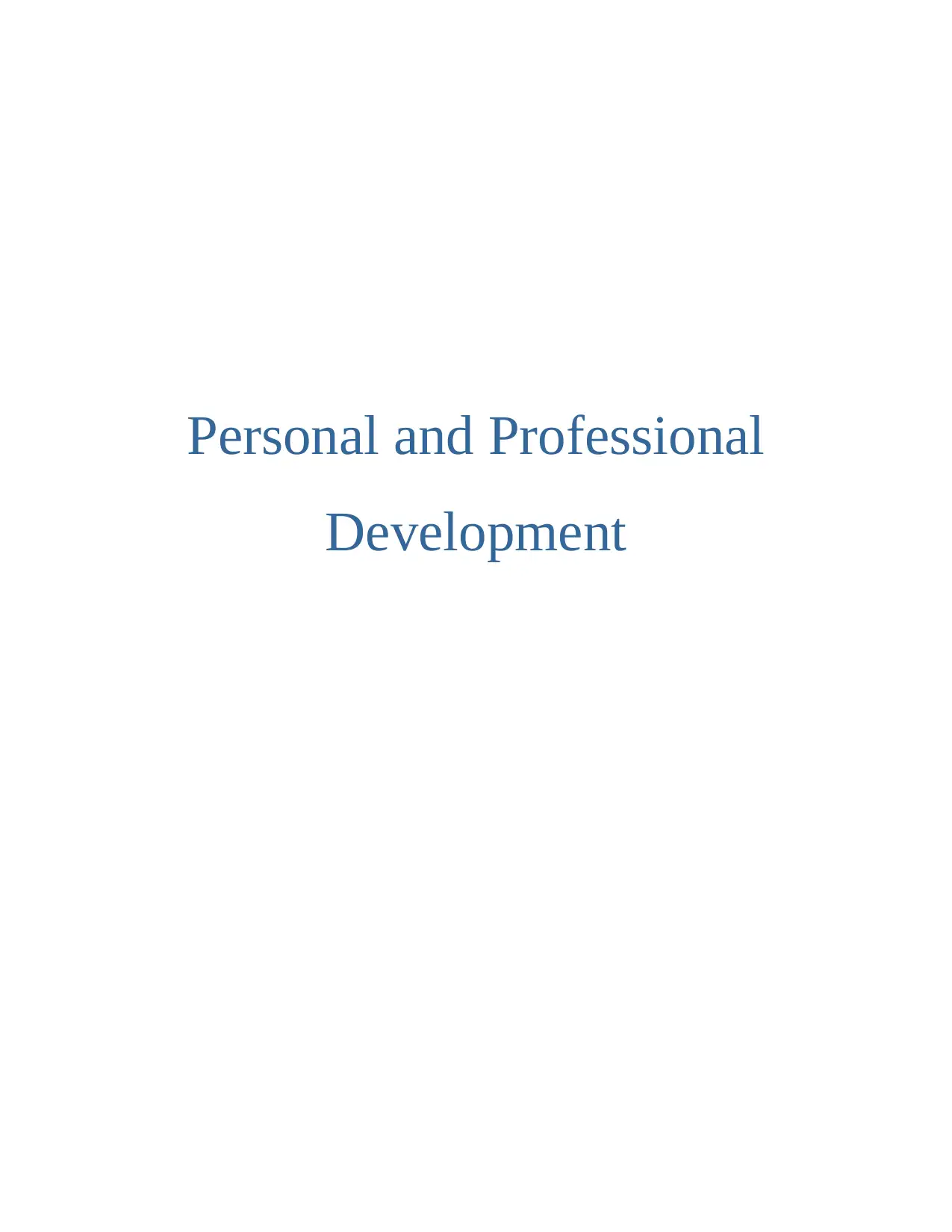
Personal and Professional
Development
Development
Paraphrase This Document
Need a fresh take? Get an instant paraphrase of this document with our AI Paraphraser
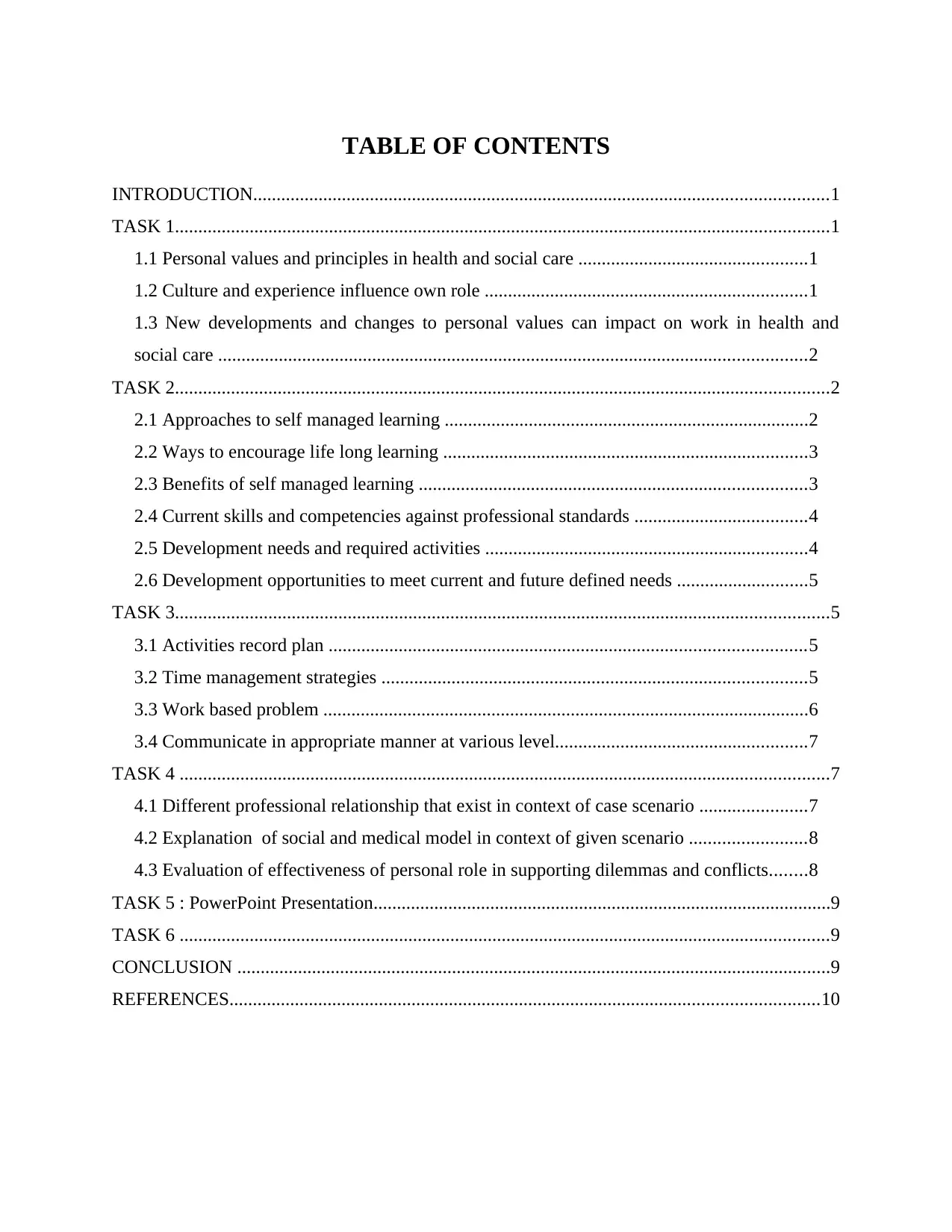
TABLE OF CONTENTS
INTRODUCTION...........................................................................................................................1
TASK 1............................................................................................................................................1
1.1 Personal values and principles in health and social care .................................................1
1.2 Culture and experience influence own role .....................................................................1
1.3 New developments and changes to personal values can impact on work in health and
social care ..............................................................................................................................2
TASK 2............................................................................................................................................2
2.1 Approaches to self managed learning ..............................................................................2
2.2 Ways to encourage life long learning ..............................................................................3
2.3 Benefits of self managed learning ...................................................................................3
2.4 Current skills and competencies against professional standards .....................................4
2.5 Development needs and required activities .....................................................................4
2.6 Development opportunities to meet current and future defined needs ............................5
TASK 3............................................................................................................................................5
3.1 Activities record plan ......................................................................................................5
3.2 Time management strategies ...........................................................................................5
3.3 Work based problem ........................................................................................................6
3.4 Communicate in appropriate manner at various level......................................................7
TASK 4 ...........................................................................................................................................7
4.1 Different professional relationship that exist in context of case scenario .......................7
4.2 Explanation of social and medical model in context of given scenario .........................8
4.3 Evaluation of effectiveness of personal role in supporting dilemmas and conflicts........8
TASK 5 : PowerPoint Presentation..................................................................................................9
TASK 6 ...........................................................................................................................................9
CONCLUSION ...............................................................................................................................9
REFERENCES..............................................................................................................................10
INTRODUCTION...........................................................................................................................1
TASK 1............................................................................................................................................1
1.1 Personal values and principles in health and social care .................................................1
1.2 Culture and experience influence own role .....................................................................1
1.3 New developments and changes to personal values can impact on work in health and
social care ..............................................................................................................................2
TASK 2............................................................................................................................................2
2.1 Approaches to self managed learning ..............................................................................2
2.2 Ways to encourage life long learning ..............................................................................3
2.3 Benefits of self managed learning ...................................................................................3
2.4 Current skills and competencies against professional standards .....................................4
2.5 Development needs and required activities .....................................................................4
2.6 Development opportunities to meet current and future defined needs ............................5
TASK 3............................................................................................................................................5
3.1 Activities record plan ......................................................................................................5
3.2 Time management strategies ...........................................................................................5
3.3 Work based problem ........................................................................................................6
3.4 Communicate in appropriate manner at various level......................................................7
TASK 4 ...........................................................................................................................................7
4.1 Different professional relationship that exist in context of case scenario .......................7
4.2 Explanation of social and medical model in context of given scenario .........................8
4.3 Evaluation of effectiveness of personal role in supporting dilemmas and conflicts........8
TASK 5 : PowerPoint Presentation..................................................................................................9
TASK 6 ...........................................................................................................................................9
CONCLUSION ...............................................................................................................................9
REFERENCES..............................................................................................................................10
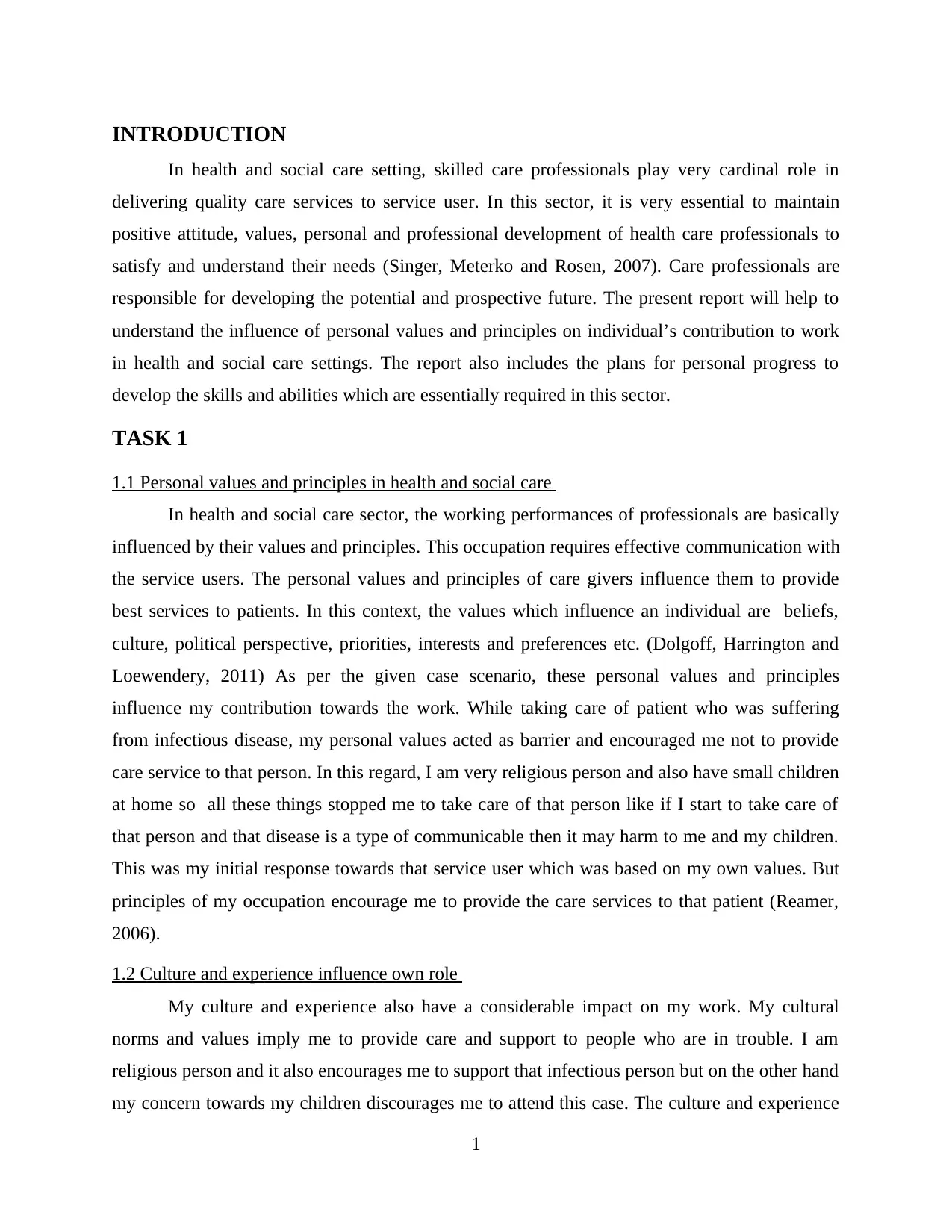
INTRODUCTION
In health and social care setting, skilled care professionals play very cardinal role in
delivering quality care services to service user. In this sector, it is very essential to maintain
positive attitude, values, personal and professional development of health care professionals to
satisfy and understand their needs (Singer, Meterko and Rosen, 2007). Care professionals are
responsible for developing the potential and prospective future. The present report will help to
understand the influence of personal values and principles on individual’s contribution to work
in health and social care settings. The report also includes the plans for personal progress to
develop the skills and abilities which are essentially required in this sector.
TASK 1
1.1 Personal values and principles in health and social care
In health and social care sector, the working performances of professionals are basically
influenced by their values and principles. This occupation requires effective communication with
the service users. The personal values and principles of care givers influence them to provide
best services to patients. In this context, the values which influence an individual are beliefs,
culture, political perspective, priorities, interests and preferences etc. (Dolgoff, Harrington and
Loewendery, 2011) As per the given case scenario, these personal values and principles
influence my contribution towards the work. While taking care of patient who was suffering
from infectious disease, my personal values acted as barrier and encouraged me not to provide
care service to that person. In this regard, I am very religious person and also have small children
at home so all these things stopped me to take care of that person like if I start to take care of
that person and that disease is a type of communicable then it may harm to me and my children.
This was my initial response towards that service user which was based on my own values. But
principles of my occupation encourage me to provide the care services to that patient (Reamer,
2006).
1.2 Culture and experience influence own role
My culture and experience also have a considerable impact on my work. My cultural
norms and values imply me to provide care and support to people who are in trouble. I am
religious person and it also encourages me to support that infectious person but on the other hand
my concern towards my children discourages me to attend this case. The culture and experience
1
In health and social care setting, skilled care professionals play very cardinal role in
delivering quality care services to service user. In this sector, it is very essential to maintain
positive attitude, values, personal and professional development of health care professionals to
satisfy and understand their needs (Singer, Meterko and Rosen, 2007). Care professionals are
responsible for developing the potential and prospective future. The present report will help to
understand the influence of personal values and principles on individual’s contribution to work
in health and social care settings. The report also includes the plans for personal progress to
develop the skills and abilities which are essentially required in this sector.
TASK 1
1.1 Personal values and principles in health and social care
In health and social care sector, the working performances of professionals are basically
influenced by their values and principles. This occupation requires effective communication with
the service users. The personal values and principles of care givers influence them to provide
best services to patients. In this context, the values which influence an individual are beliefs,
culture, political perspective, priorities, interests and preferences etc. (Dolgoff, Harrington and
Loewendery, 2011) As per the given case scenario, these personal values and principles
influence my contribution towards the work. While taking care of patient who was suffering
from infectious disease, my personal values acted as barrier and encouraged me not to provide
care service to that person. In this regard, I am very religious person and also have small children
at home so all these things stopped me to take care of that person like if I start to take care of
that person and that disease is a type of communicable then it may harm to me and my children.
This was my initial response towards that service user which was based on my own values. But
principles of my occupation encourage me to provide the care services to that patient (Reamer,
2006).
1.2 Culture and experience influence own role
My culture and experience also have a considerable impact on my work. My cultural
norms and values imply me to provide care and support to people who are in trouble. I am
religious person and it also encourages me to support that infectious person but on the other hand
my concern towards my children discourages me to attend this case. The culture and experience
1
⊘ This is a preview!⊘
Do you want full access?
Subscribe today to unlock all pages.

Trusted by 1+ million students worldwide
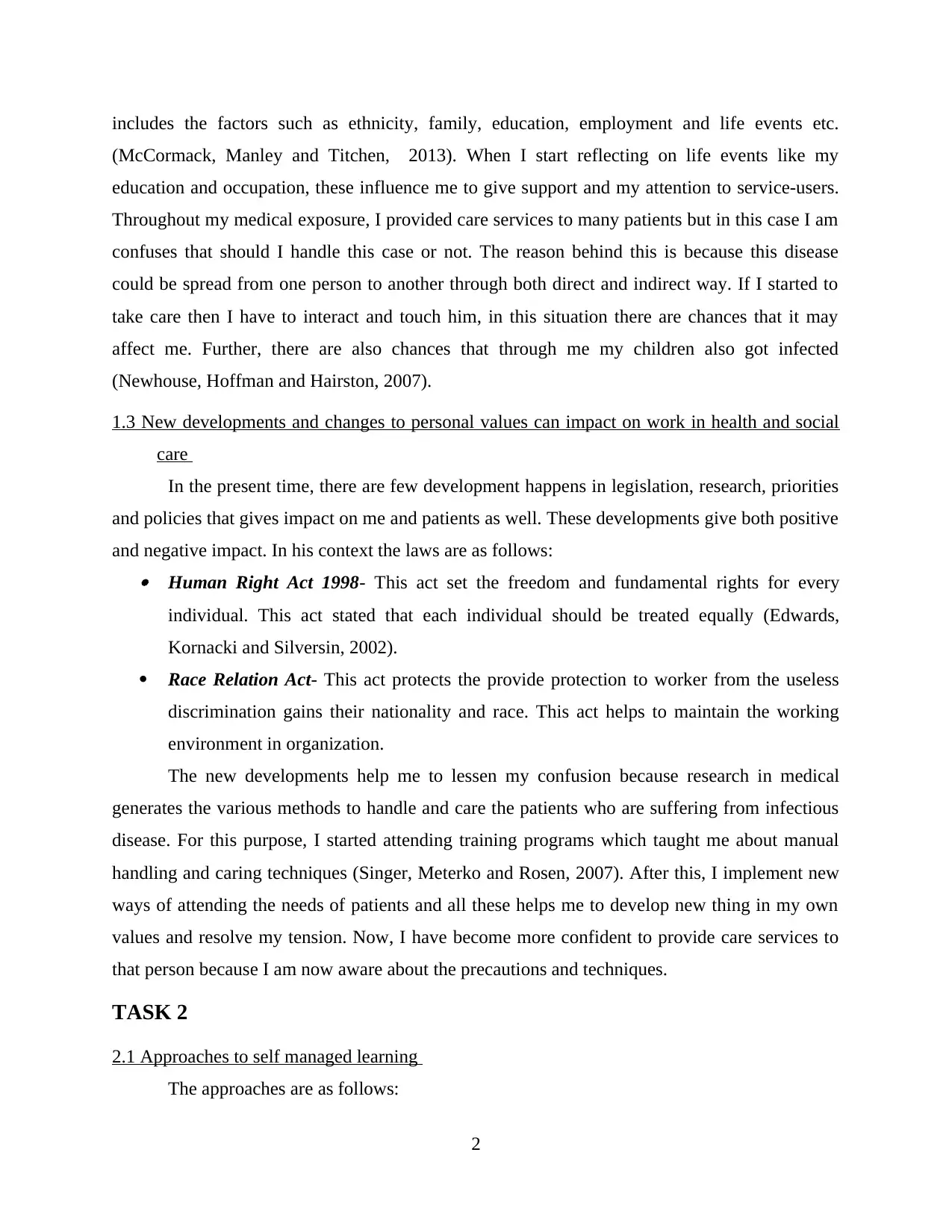
includes the factors such as ethnicity, family, education, employment and life events etc.
(McCormack, Manley and Titchen, 2013). When I start reflecting on life events like my
education and occupation, these influence me to give support and my attention to service-users.
Throughout my medical exposure, I provided care services to many patients but in this case I am
confuses that should I handle this case or not. The reason behind this is because this disease
could be spread from one person to another through both direct and indirect way. If I started to
take care then I have to interact and touch him, in this situation there are chances that it may
affect me. Further, there are also chances that through me my children also got infected
(Newhouse, Hoffman and Hairston, 2007).
1.3 New developments and changes to personal values can impact on work in health and social
care
In the present time, there are few development happens in legislation, research, priorities
and policies that gives impact on me and patients as well. These developments give both positive
and negative impact. In his context the laws are as follows: Human Right Act 1998- This act set the freedom and fundamental rights for every
individual. This act stated that each individual should be treated equally (Edwards,
Kornacki and Silversin, 2002).
Race Relation Act- This act protects the provide protection to worker from the useless
discrimination gains their nationality and race. This act helps to maintain the working
environment in organization.
The new developments help me to lessen my confusion because research in medical
generates the various methods to handle and care the patients who are suffering from infectious
disease. For this purpose, I started attending training programs which taught me about manual
handling and caring techniques (Singer, Meterko and Rosen, 2007). After this, I implement new
ways of attending the needs of patients and all these helps me to develop new thing in my own
values and resolve my tension. Now, I have become more confident to provide care services to
that person because I am now aware about the precautions and techniques.
TASK 2
2.1 Approaches to self managed learning
The approaches are as follows:
2
(McCormack, Manley and Titchen, 2013). When I start reflecting on life events like my
education and occupation, these influence me to give support and my attention to service-users.
Throughout my medical exposure, I provided care services to many patients but in this case I am
confuses that should I handle this case or not. The reason behind this is because this disease
could be spread from one person to another through both direct and indirect way. If I started to
take care then I have to interact and touch him, in this situation there are chances that it may
affect me. Further, there are also chances that through me my children also got infected
(Newhouse, Hoffman and Hairston, 2007).
1.3 New developments and changes to personal values can impact on work in health and social
care
In the present time, there are few development happens in legislation, research, priorities
and policies that gives impact on me and patients as well. These developments give both positive
and negative impact. In his context the laws are as follows: Human Right Act 1998- This act set the freedom and fundamental rights for every
individual. This act stated that each individual should be treated equally (Edwards,
Kornacki and Silversin, 2002).
Race Relation Act- This act protects the provide protection to worker from the useless
discrimination gains their nationality and race. This act helps to maintain the working
environment in organization.
The new developments help me to lessen my confusion because research in medical
generates the various methods to handle and care the patients who are suffering from infectious
disease. For this purpose, I started attending training programs which taught me about manual
handling and caring techniques (Singer, Meterko and Rosen, 2007). After this, I implement new
ways of attending the needs of patients and all these helps me to develop new thing in my own
values and resolve my tension. Now, I have become more confident to provide care services to
that person because I am now aware about the precautions and techniques.
TASK 2
2.1 Approaches to self managed learning
The approaches are as follows:
2
Paraphrase This Document
Need a fresh take? Get an instant paraphrase of this document with our AI Paraphraser
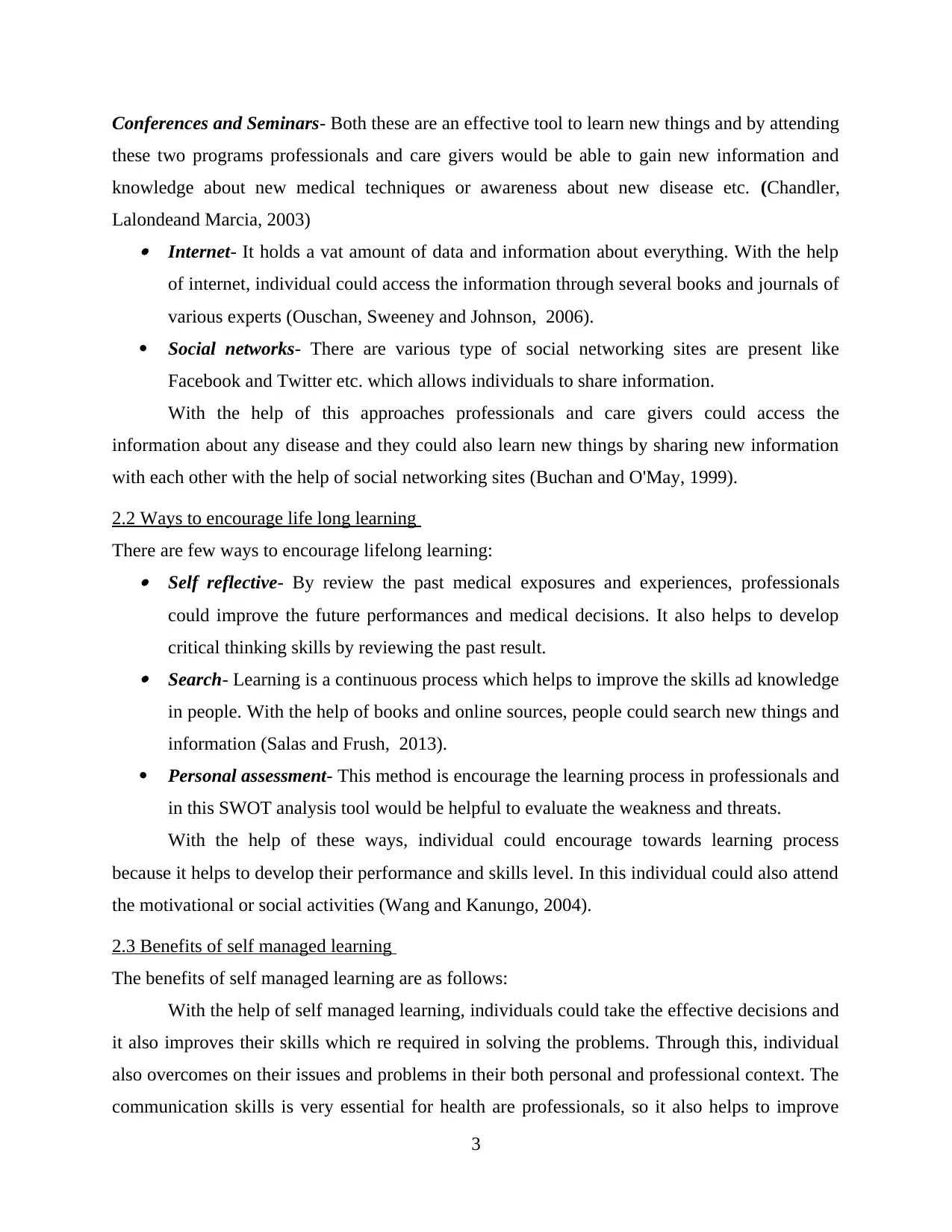
Conferences and Seminars- Both these are an effective tool to learn new things and by attending
these two programs professionals and care givers would be able to gain new information and
knowledge about new medical techniques or awareness about new disease etc. (Chandler,
Lalondeand Marcia, 2003) Internet- It holds a vat amount of data and information about everything. With the help
of internet, individual could access the information through several books and journals of
various experts (Ouschan, Sweeney and Johnson, 2006).
Social networks- There are various type of social networking sites are present like
Facebook and Twitter etc. which allows individuals to share information.
With the help of this approaches professionals and care givers could access the
information about any disease and they could also learn new things by sharing new information
with each other with the help of social networking sites (Buchan and O'May, 1999).
2.2 Ways to encourage life long learning
There are few ways to encourage lifelong learning: Self reflective- By review the past medical exposures and experiences, professionals
could improve the future performances and medical decisions. It also helps to develop
critical thinking skills by reviewing the past result. Search- Learning is a continuous process which helps to improve the skills ad knowledge
in people. With the help of books and online sources, people could search new things and
information (Salas and Frush, 2013).
Personal assessment- This method is encourage the learning process in professionals and
in this SWOT analysis tool would be helpful to evaluate the weakness and threats.
With the help of these ways, individual could encourage towards learning process
because it helps to develop their performance and skills level. In this individual could also attend
the motivational or social activities (Wang and Kanungo, 2004).
2.3 Benefits of self managed learning
The benefits of self managed learning are as follows:
With the help of self managed learning, individuals could take the effective decisions and
it also improves their skills which re required in solving the problems. Through this, individual
also overcomes on their issues and problems in their both personal and professional context. The
communication skills is very essential for health are professionals, so it also helps to improve
3
these two programs professionals and care givers would be able to gain new information and
knowledge about new medical techniques or awareness about new disease etc. (Chandler,
Lalondeand Marcia, 2003) Internet- It holds a vat amount of data and information about everything. With the help
of internet, individual could access the information through several books and journals of
various experts (Ouschan, Sweeney and Johnson, 2006).
Social networks- There are various type of social networking sites are present like
Facebook and Twitter etc. which allows individuals to share information.
With the help of this approaches professionals and care givers could access the
information about any disease and they could also learn new things by sharing new information
with each other with the help of social networking sites (Buchan and O'May, 1999).
2.2 Ways to encourage life long learning
There are few ways to encourage lifelong learning: Self reflective- By review the past medical exposures and experiences, professionals
could improve the future performances and medical decisions. It also helps to develop
critical thinking skills by reviewing the past result. Search- Learning is a continuous process which helps to improve the skills ad knowledge
in people. With the help of books and online sources, people could search new things and
information (Salas and Frush, 2013).
Personal assessment- This method is encourage the learning process in professionals and
in this SWOT analysis tool would be helpful to evaluate the weakness and threats.
With the help of these ways, individual could encourage towards learning process
because it helps to develop their performance and skills level. In this individual could also attend
the motivational or social activities (Wang and Kanungo, 2004).
2.3 Benefits of self managed learning
The benefits of self managed learning are as follows:
With the help of self managed learning, individuals could take the effective decisions and
it also improves their skills which re required in solving the problems. Through this, individual
also overcomes on their issues and problems in their both personal and professional context. The
communication skills is very essential for health are professionals, so it also helps to improve
3
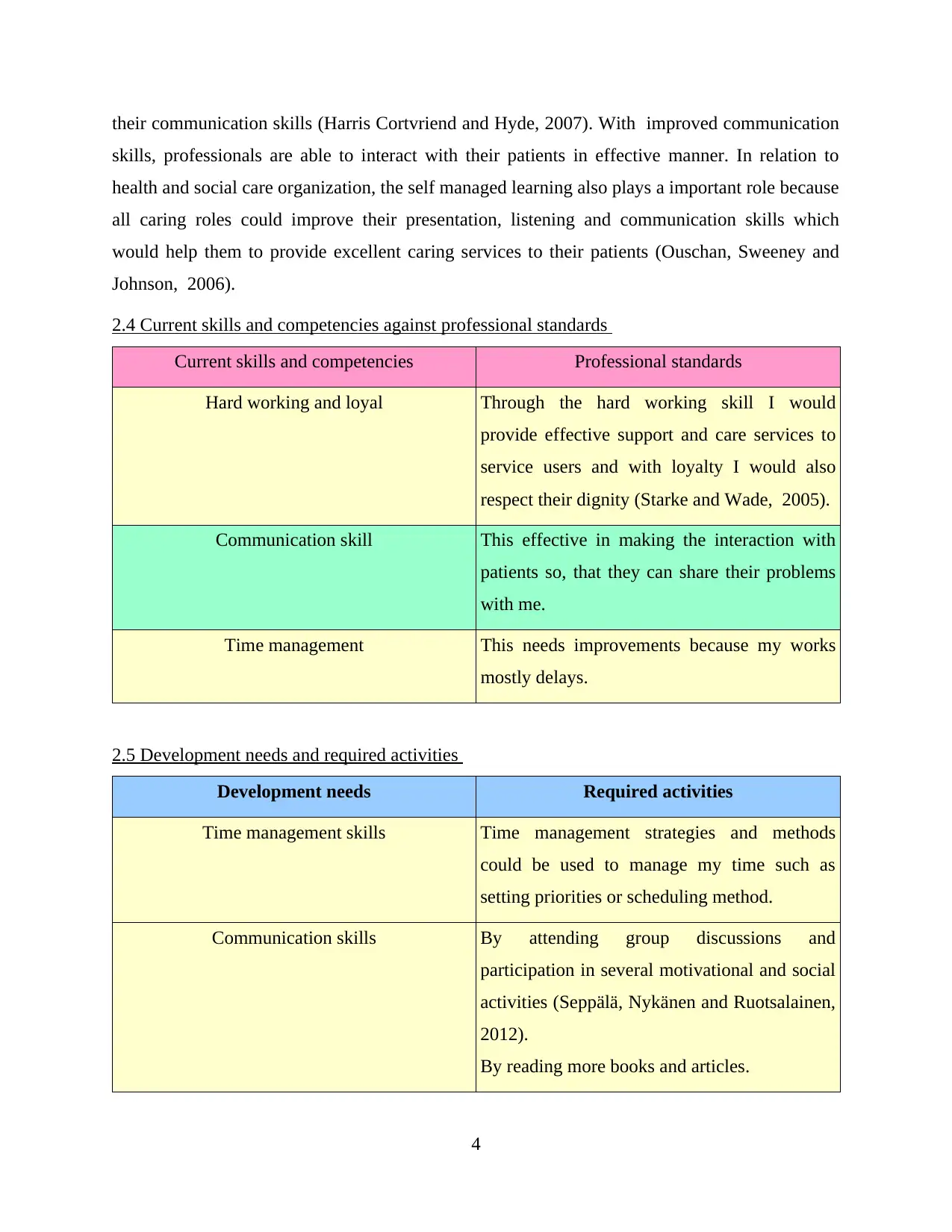
their communication skills (Harris Cortvriend and Hyde, 2007). With improved communication
skills, professionals are able to interact with their patients in effective manner. In relation to
health and social care organization, the self managed learning also plays a important role because
all caring roles could improve their presentation, listening and communication skills which
would help them to provide excellent caring services to their patients (Ouschan, Sweeney and
Johnson, 2006).
2.4 Current skills and competencies against professional standards
Current skills and competencies Professional standards
Hard working and loyal Through the hard working skill I would
provide effective support and care services to
service users and with loyalty I would also
respect their dignity (Starke and Wade, 2005).
Communication skill This effective in making the interaction with
patients so, that they can share their problems
with me.
Time management This needs improvements because my works
mostly delays.
2.5 Development needs and required activities
Development needs Required activities
Time management skills Time management strategies and methods
could be used to manage my time such as
setting priorities or scheduling method.
Communication skills By attending group discussions and
participation in several motivational and social
activities (Seppälä, Nykänen and Ruotsalainen,
2012).
By reading more books and articles.
4
skills, professionals are able to interact with their patients in effective manner. In relation to
health and social care organization, the self managed learning also plays a important role because
all caring roles could improve their presentation, listening and communication skills which
would help them to provide excellent caring services to their patients (Ouschan, Sweeney and
Johnson, 2006).
2.4 Current skills and competencies against professional standards
Current skills and competencies Professional standards
Hard working and loyal Through the hard working skill I would
provide effective support and care services to
service users and with loyalty I would also
respect their dignity (Starke and Wade, 2005).
Communication skill This effective in making the interaction with
patients so, that they can share their problems
with me.
Time management This needs improvements because my works
mostly delays.
2.5 Development needs and required activities
Development needs Required activities
Time management skills Time management strategies and methods
could be used to manage my time such as
setting priorities or scheduling method.
Communication skills By attending group discussions and
participation in several motivational and social
activities (Seppälä, Nykänen and Ruotsalainen,
2012).
By reading more books and articles.
4
⊘ This is a preview!⊘
Do you want full access?
Subscribe today to unlock all pages.

Trusted by 1+ million students worldwide
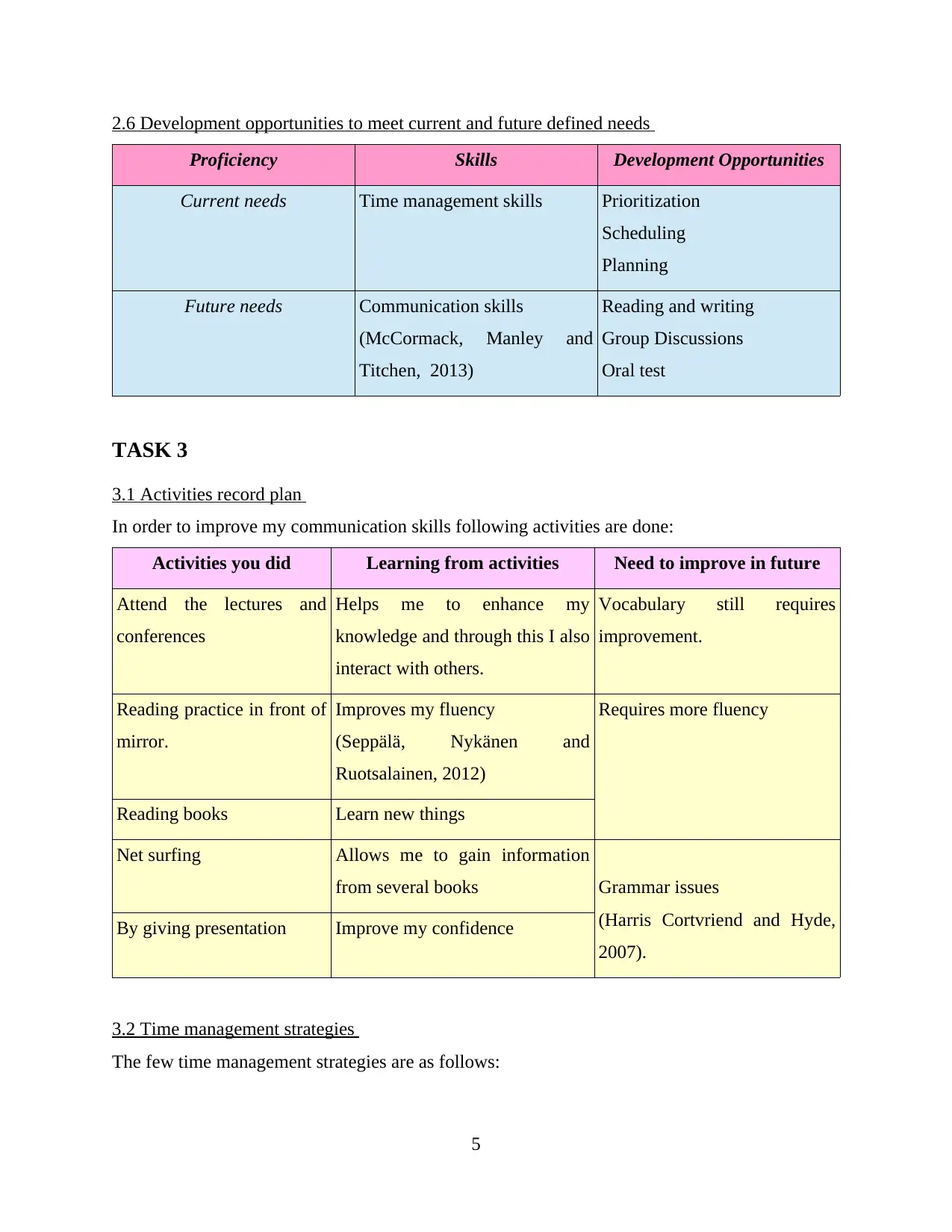
2.6 Development opportunities to meet current and future defined needs
Proficiency Skills Development Opportunities
Current needs Time management skills Prioritization
Scheduling
Planning
Future needs Communication skills
(McCormack, Manley and
Titchen, 2013)
Reading and writing
Group Discussions
Oral test
TASK 3
3.1 Activities record plan
In order to improve my communication skills following activities are done:
Activities you did Learning from activities Need to improve in future
Attend the lectures and
conferences
Helps me to enhance my
knowledge and through this I also
interact with others.
Vocabulary still requires
improvement.
Reading practice in front of
mirror.
Improves my fluency
(Seppälä, Nykänen and
Ruotsalainen, 2012)
Requires more fluency
Reading books Learn new things
Net surfing Allows me to gain information
from several books Grammar issues
(Harris Cortvriend and Hyde,
2007).
By giving presentation Improve my confidence
3.2 Time management strategies
The few time management strategies are as follows:
5
Proficiency Skills Development Opportunities
Current needs Time management skills Prioritization
Scheduling
Planning
Future needs Communication skills
(McCormack, Manley and
Titchen, 2013)
Reading and writing
Group Discussions
Oral test
TASK 3
3.1 Activities record plan
In order to improve my communication skills following activities are done:
Activities you did Learning from activities Need to improve in future
Attend the lectures and
conferences
Helps me to enhance my
knowledge and through this I also
interact with others.
Vocabulary still requires
improvement.
Reading practice in front of
mirror.
Improves my fluency
(Seppälä, Nykänen and
Ruotsalainen, 2012)
Requires more fluency
Reading books Learn new things
Net surfing Allows me to gain information
from several books Grammar issues
(Harris Cortvriend and Hyde,
2007).
By giving presentation Improve my confidence
3.2 Time management strategies
The few time management strategies are as follows:
5
Paraphrase This Document
Need a fresh take? Get an instant paraphrase of this document with our AI Paraphraser
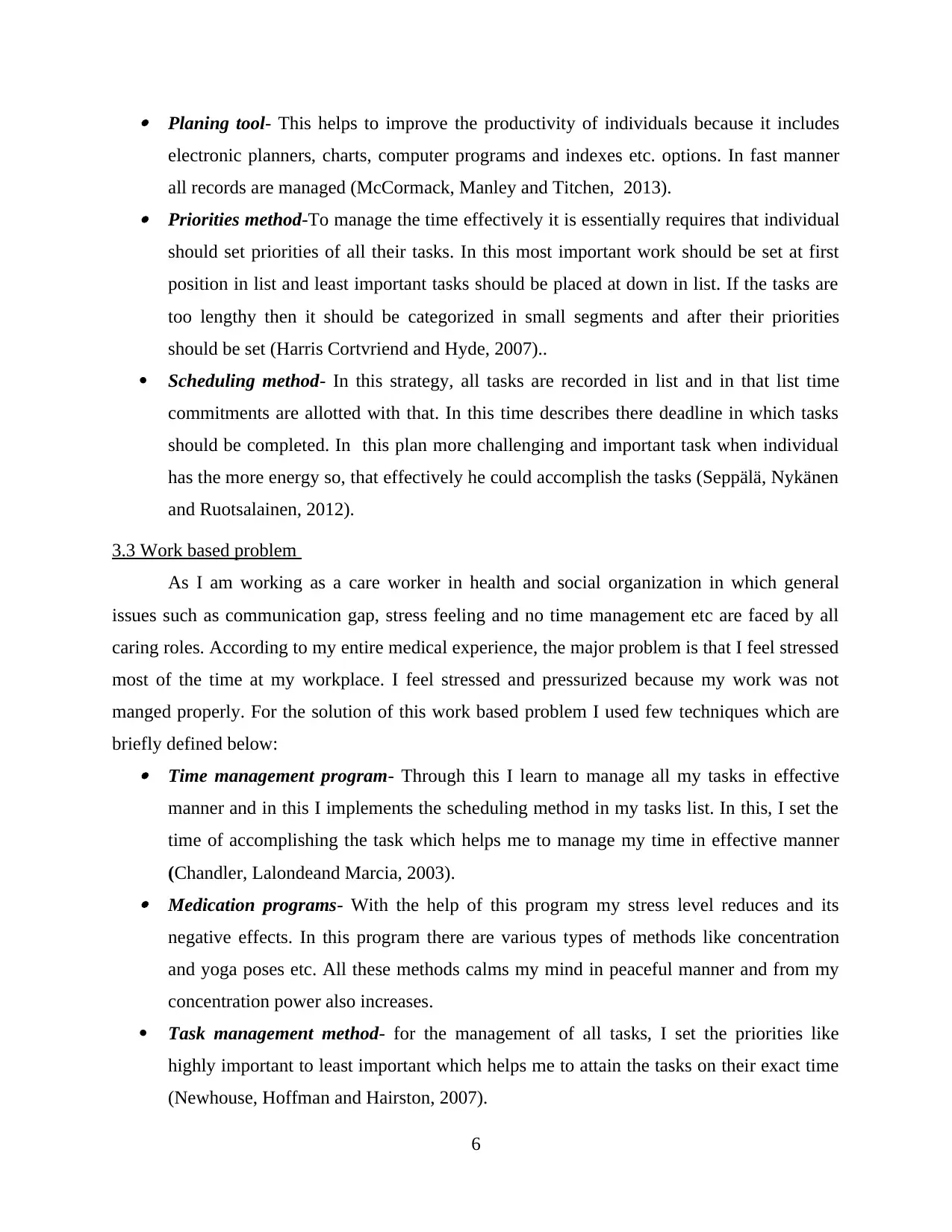
Planing tool- This helps to improve the productivity of individuals because it includes
electronic planners, charts, computer programs and indexes etc. options. In fast manner
all records are managed (McCormack, Manley and Titchen, 2013). Priorities method-To manage the time effectively it is essentially requires that individual
should set priorities of all their tasks. In this most important work should be set at first
position in list and least important tasks should be placed at down in list. If the tasks are
too lengthy then it should be categorized in small segments and after their priorities
should be set (Harris Cortvriend and Hyde, 2007)..
Scheduling method- In this strategy, all tasks are recorded in list and in that list time
commitments are allotted with that. In this time describes there deadline in which tasks
should be completed. In this plan more challenging and important task when individual
has the more energy so, that effectively he could accomplish the tasks (Seppälä, Nykänen
and Ruotsalainen, 2012).
3.3 Work based problem
As I am working as a care worker in health and social organization in which general
issues such as communication gap, stress feeling and no time management etc are faced by all
caring roles. According to my entire medical experience, the major problem is that I feel stressed
most of the time at my workplace. I feel stressed and pressurized because my work was not
manged properly. For the solution of this work based problem I used few techniques which are
briefly defined below: Time management program- Through this I learn to manage all my tasks in effective
manner and in this I implements the scheduling method in my tasks list. In this, I set the
time of accomplishing the task which helps me to manage my time in effective manner
(Chandler, Lalondeand Marcia, 2003). Medication programs- With the help of this program my stress level reduces and its
negative effects. In this program there are various types of methods like concentration
and yoga poses etc. All these methods calms my mind in peaceful manner and from my
concentration power also increases.
Task management method- for the management of all tasks, I set the priorities like
highly important to least important which helps me to attain the tasks on their exact time
(Newhouse, Hoffman and Hairston, 2007).
6
electronic planners, charts, computer programs and indexes etc. options. In fast manner
all records are managed (McCormack, Manley and Titchen, 2013). Priorities method-To manage the time effectively it is essentially requires that individual
should set priorities of all their tasks. In this most important work should be set at first
position in list and least important tasks should be placed at down in list. If the tasks are
too lengthy then it should be categorized in small segments and after their priorities
should be set (Harris Cortvriend and Hyde, 2007)..
Scheduling method- In this strategy, all tasks are recorded in list and in that list time
commitments are allotted with that. In this time describes there deadline in which tasks
should be completed. In this plan more challenging and important task when individual
has the more energy so, that effectively he could accomplish the tasks (Seppälä, Nykänen
and Ruotsalainen, 2012).
3.3 Work based problem
As I am working as a care worker in health and social organization in which general
issues such as communication gap, stress feeling and no time management etc are faced by all
caring roles. According to my entire medical experience, the major problem is that I feel stressed
most of the time at my workplace. I feel stressed and pressurized because my work was not
manged properly. For the solution of this work based problem I used few techniques which are
briefly defined below: Time management program- Through this I learn to manage all my tasks in effective
manner and in this I implements the scheduling method in my tasks list. In this, I set the
time of accomplishing the task which helps me to manage my time in effective manner
(Chandler, Lalondeand Marcia, 2003). Medication programs- With the help of this program my stress level reduces and its
negative effects. In this program there are various types of methods like concentration
and yoga poses etc. All these methods calms my mind in peaceful manner and from my
concentration power also increases.
Task management method- for the management of all tasks, I set the priorities like
highly important to least important which helps me to attain the tasks on their exact time
(Newhouse, Hoffman and Hairston, 2007).
6
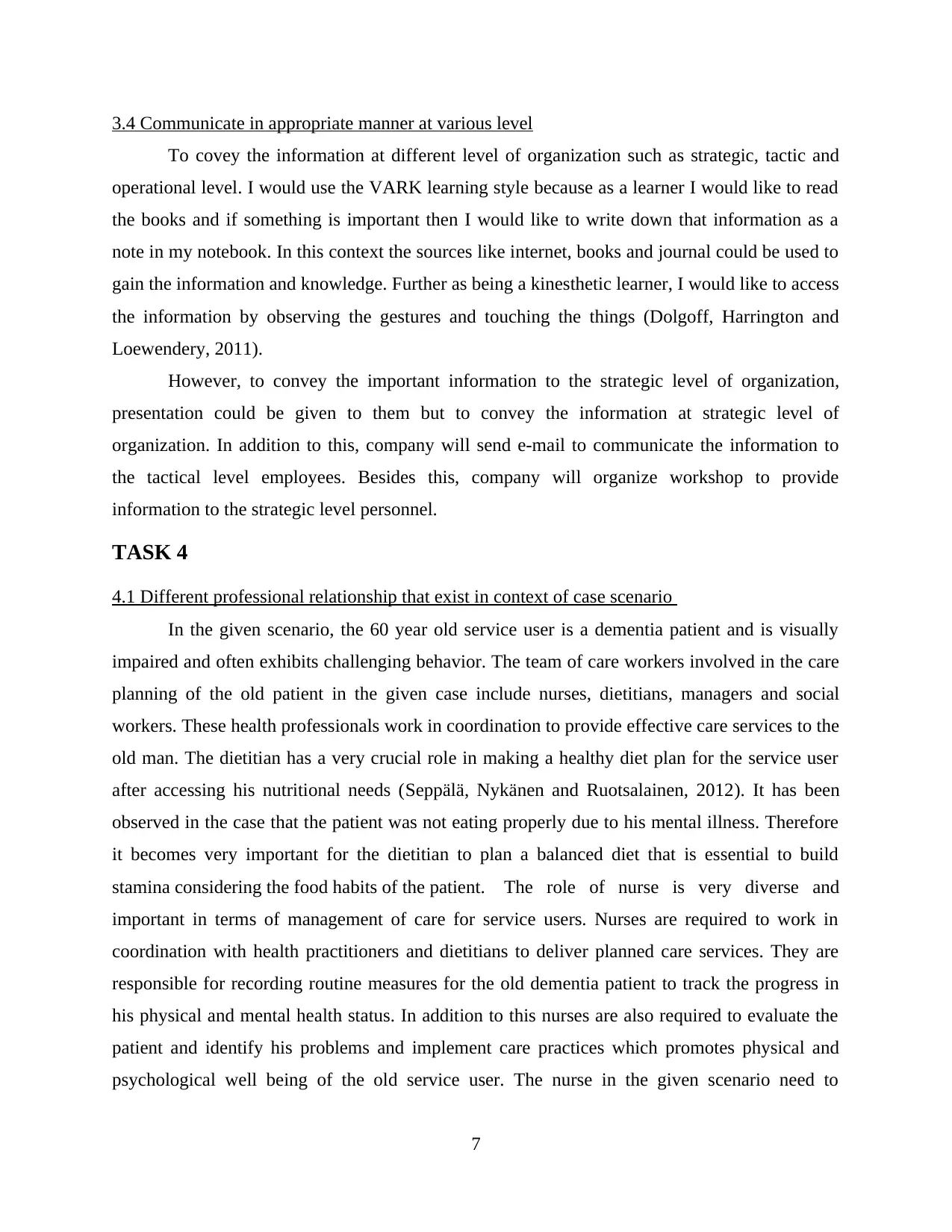
3.4 Communicate in appropriate manner at various level
To covey the information at different level of organization such as strategic, tactic and
operational level. I would use the VARK learning style because as a learner I would like to read
the books and if something is important then I would like to write down that information as a
note in my notebook. In this context the sources like internet, books and journal could be used to
gain the information and knowledge. Further as being a kinesthetic learner, I would like to access
the information by observing the gestures and touching the things (Dolgoff, Harrington and
Loewendery, 2011).
However, to convey the important information to the strategic level of organization,
presentation could be given to them but to convey the information at strategic level of
organization. In addition to this, company will send e-mail to communicate the information to
the tactical level employees. Besides this, company will organize workshop to provide
information to the strategic level personnel.
TASK 4
4.1 Different professional relationship that exist in context of case scenario
In the given scenario, the 60 year old service user is a dementia patient and is visually
impaired and often exhibits challenging behavior. The team of care workers involved in the care
planning of the old patient in the given case include nurses, dietitians, managers and social
workers. These health professionals work in coordination to provide effective care services to the
old man. The dietitian has a very crucial role in making a healthy diet plan for the service user
after accessing his nutritional needs (Seppälä, Nykänen and Ruotsalainen, 2012). It has been
observed in the case that the patient was not eating properly due to his mental illness. Therefore
it becomes very important for the dietitian to plan a balanced diet that is essential to build
stamina considering the food habits of the patient. The role of nurse is very diverse and
important in terms of management of care for service users. Nurses are required to work in
coordination with health practitioners and dietitians to deliver planned care services. They are
responsible for recording routine measures for the old dementia patient to track the progress in
his physical and mental health status. In addition to this nurses are also required to evaluate the
patient and identify his problems and implement care practices which promotes physical and
psychological well being of the old service user. The nurse in the given scenario need to
7
To covey the information at different level of organization such as strategic, tactic and
operational level. I would use the VARK learning style because as a learner I would like to read
the books and if something is important then I would like to write down that information as a
note in my notebook. In this context the sources like internet, books and journal could be used to
gain the information and knowledge. Further as being a kinesthetic learner, I would like to access
the information by observing the gestures and touching the things (Dolgoff, Harrington and
Loewendery, 2011).
However, to convey the important information to the strategic level of organization,
presentation could be given to them but to convey the information at strategic level of
organization. In addition to this, company will send e-mail to communicate the information to
the tactical level employees. Besides this, company will organize workshop to provide
information to the strategic level personnel.
TASK 4
4.1 Different professional relationship that exist in context of case scenario
In the given scenario, the 60 year old service user is a dementia patient and is visually
impaired and often exhibits challenging behavior. The team of care workers involved in the care
planning of the old patient in the given case include nurses, dietitians, managers and social
workers. These health professionals work in coordination to provide effective care services to the
old man. The dietitian has a very crucial role in making a healthy diet plan for the service user
after accessing his nutritional needs (Seppälä, Nykänen and Ruotsalainen, 2012). It has been
observed in the case that the patient was not eating properly due to his mental illness. Therefore
it becomes very important for the dietitian to plan a balanced diet that is essential to build
stamina considering the food habits of the patient. The role of nurse is very diverse and
important in terms of management of care for service users. Nurses are required to work in
coordination with health practitioners and dietitians to deliver planned care services. They are
responsible for recording routine measures for the old dementia patient to track the progress in
his physical and mental health status. In addition to this nurses are also required to evaluate the
patient and identify his problems and implement care practices which promotes physical and
psychological well being of the old service user. The nurse in the given scenario need to
7
⊘ This is a preview!⊘
Do you want full access?
Subscribe today to unlock all pages.

Trusted by 1+ million students worldwide
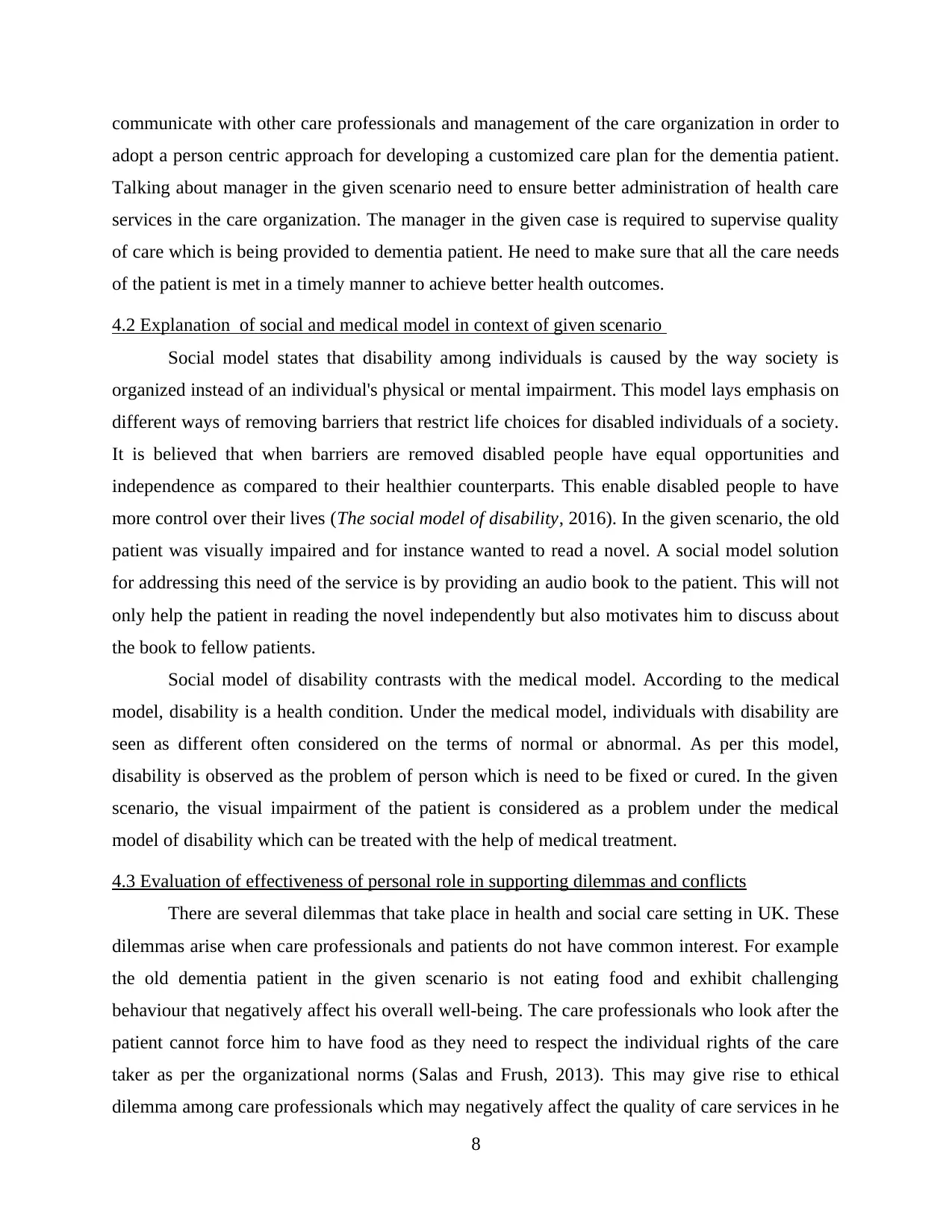
communicate with other care professionals and management of the care organization in order to
adopt a person centric approach for developing a customized care plan for the dementia patient.
Talking about manager in the given scenario need to ensure better administration of health care
services in the care organization. The manager in the given case is required to supervise quality
of care which is being provided to dementia patient. He need to make sure that all the care needs
of the patient is met in a timely manner to achieve better health outcomes.
4.2 Explanation of social and medical model in context of given scenario
Social model states that disability among individuals is caused by the way society is
organized instead of an individual's physical or mental impairment. This model lays emphasis on
different ways of removing barriers that restrict life choices for disabled individuals of a society.
It is believed that when barriers are removed disabled people have equal opportunities and
independence as compared to their healthier counterparts. This enable disabled people to have
more control over their lives (The social model of disability, 2016). In the given scenario, the old
patient was visually impaired and for instance wanted to read a novel. A social model solution
for addressing this need of the service is by providing an audio book to the patient. This will not
only help the patient in reading the novel independently but also motivates him to discuss about
the book to fellow patients.
Social model of disability contrasts with the medical model. According to the medical
model, disability is a health condition. Under the medical model, individuals with disability are
seen as different often considered on the terms of normal or abnormal. As per this model,
disability is observed as the problem of person which is need to be fixed or cured. In the given
scenario, the visual impairment of the patient is considered as a problem under the medical
model of disability which can be treated with the help of medical treatment.
4.3 Evaluation of effectiveness of personal role in supporting dilemmas and conflicts
There are several dilemmas that take place in health and social care setting in UK. These
dilemmas arise when care professionals and patients do not have common interest. For example
the old dementia patient in the given scenario is not eating food and exhibit challenging
behaviour that negatively affect his overall well-being. The care professionals who look after the
patient cannot force him to have food as they need to respect the individual rights of the care
taker as per the organizational norms (Salas and Frush, 2013). This may give rise to ethical
dilemma among care professionals which may negatively affect the quality of care services in he
8
adopt a person centric approach for developing a customized care plan for the dementia patient.
Talking about manager in the given scenario need to ensure better administration of health care
services in the care organization. The manager in the given case is required to supervise quality
of care which is being provided to dementia patient. He need to make sure that all the care needs
of the patient is met in a timely manner to achieve better health outcomes.
4.2 Explanation of social and medical model in context of given scenario
Social model states that disability among individuals is caused by the way society is
organized instead of an individual's physical or mental impairment. This model lays emphasis on
different ways of removing barriers that restrict life choices for disabled individuals of a society.
It is believed that when barriers are removed disabled people have equal opportunities and
independence as compared to their healthier counterparts. This enable disabled people to have
more control over their lives (The social model of disability, 2016). In the given scenario, the old
patient was visually impaired and for instance wanted to read a novel. A social model solution
for addressing this need of the service is by providing an audio book to the patient. This will not
only help the patient in reading the novel independently but also motivates him to discuss about
the book to fellow patients.
Social model of disability contrasts with the medical model. According to the medical
model, disability is a health condition. Under the medical model, individuals with disability are
seen as different often considered on the terms of normal or abnormal. As per this model,
disability is observed as the problem of person which is need to be fixed or cured. In the given
scenario, the visual impairment of the patient is considered as a problem under the medical
model of disability which can be treated with the help of medical treatment.
4.3 Evaluation of effectiveness of personal role in supporting dilemmas and conflicts
There are several dilemmas that take place in health and social care setting in UK. These
dilemmas arise when care professionals and patients do not have common interest. For example
the old dementia patient in the given scenario is not eating food and exhibit challenging
behaviour that negatively affect his overall well-being. The care professionals who look after the
patient cannot force him to have food as they need to respect the individual rights of the care
taker as per the organizational norms (Salas and Frush, 2013). This may give rise to ethical
dilemma among care professionals which may negatively affect the quality of care services in he
8
Paraphrase This Document
Need a fresh take? Get an instant paraphrase of this document with our AI Paraphraser
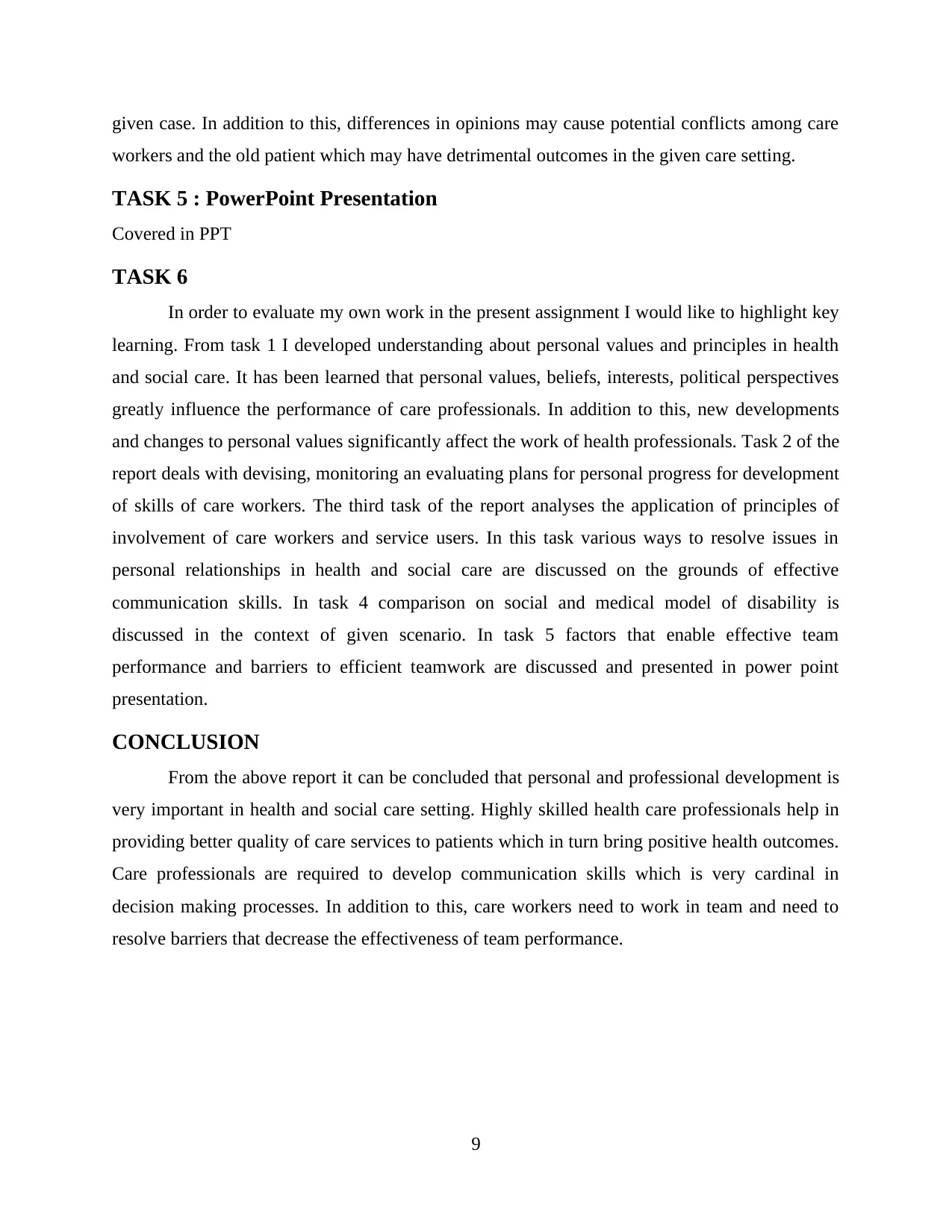
given case. In addition to this, differences in opinions may cause potential conflicts among care
workers and the old patient which may have detrimental outcomes in the given care setting.
TASK 5 : PowerPoint Presentation
Covered in PPT
TASK 6
In order to evaluate my own work in the present assignment I would like to highlight key
learning. From task 1 I developed understanding about personal values and principles in health
and social care. It has been learned that personal values, beliefs, interests, political perspectives
greatly influence the performance of care professionals. In addition to this, new developments
and changes to personal values significantly affect the work of health professionals. Task 2 of the
report deals with devising, monitoring an evaluating plans for personal progress for development
of skills of care workers. The third task of the report analyses the application of principles of
involvement of care workers and service users. In this task various ways to resolve issues in
personal relationships in health and social care are discussed on the grounds of effective
communication skills. In task 4 comparison on social and medical model of disability is
discussed in the context of given scenario. In task 5 factors that enable effective team
performance and barriers to efficient teamwork are discussed and presented in power point
presentation.
CONCLUSION
From the above report it can be concluded that personal and professional development is
very important in health and social care setting. Highly skilled health care professionals help in
providing better quality of care services to patients which in turn bring positive health outcomes.
Care professionals are required to develop communication skills which is very cardinal in
decision making processes. In addition to this, care workers need to work in team and need to
resolve barriers that decrease the effectiveness of team performance.
9
workers and the old patient which may have detrimental outcomes in the given care setting.
TASK 5 : PowerPoint Presentation
Covered in PPT
TASK 6
In order to evaluate my own work in the present assignment I would like to highlight key
learning. From task 1 I developed understanding about personal values and principles in health
and social care. It has been learned that personal values, beliefs, interests, political perspectives
greatly influence the performance of care professionals. In addition to this, new developments
and changes to personal values significantly affect the work of health professionals. Task 2 of the
report deals with devising, monitoring an evaluating plans for personal progress for development
of skills of care workers. The third task of the report analyses the application of principles of
involvement of care workers and service users. In this task various ways to resolve issues in
personal relationships in health and social care are discussed on the grounds of effective
communication skills. In task 4 comparison on social and medical model of disability is
discussed in the context of given scenario. In task 5 factors that enable effective team
performance and barriers to efficient teamwork are discussed and presented in power point
presentation.
CONCLUSION
From the above report it can be concluded that personal and professional development is
very important in health and social care setting. Highly skilled health care professionals help in
providing better quality of care services to patients which in turn bring positive health outcomes.
Care professionals are required to develop communication skills which is very cardinal in
decision making processes. In addition to this, care workers need to work in team and need to
resolve barriers that decrease the effectiveness of team performance.
9
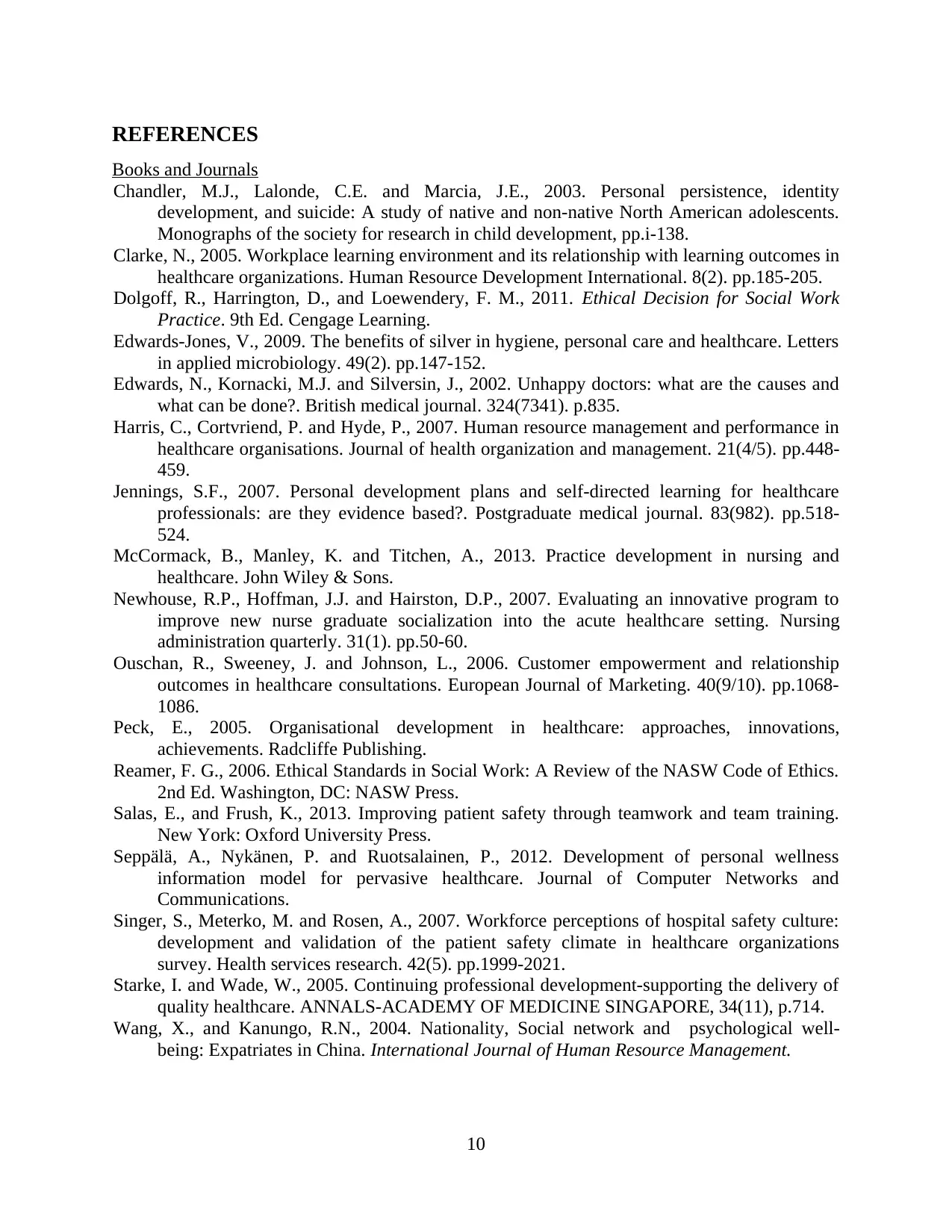
REFERENCES
Books and Journals
Chandler, M.J., Lalonde, C.E. and Marcia, J.E., 2003. Personal persistence, identity
development, and suicide: A study of native and non-native North American adolescents.
Monographs of the society for research in child development, pp.i-138.
Clarke, N., 2005. Workplace learning environment and its relationship with learning outcomes in
healthcare organizations. Human Resource Development International. 8(2). pp.185-205.
Dolgoff, R., Harrington, D., and Loewendery, F. M., 2011. Ethical Decision for Social Work
Practice. 9th Ed. Cengage Learning.
Edwards‐Jones, V., 2009. The benefits of silver in hygiene, personal care and healthcare. Letters
in applied microbiology. 49(2). pp.147-152.
Edwards, N., Kornacki, M.J. and Silversin, J., 2002. Unhappy doctors: what are the causes and
what can be done?. British medical journal. 324(7341). p.835.
Harris, C., Cortvriend, P. and Hyde, P., 2007. Human resource management and performance in
healthcare organisations. Journal of health organization and management. 21(4/5). pp.448-
459.
Jennings, S.F., 2007. Personal development plans and self-directed learning for healthcare
professionals: are they evidence based?. Postgraduate medical journal. 83(982). pp.518-
524.
McCormack, B., Manley, K. and Titchen, A., 2013. Practice development in nursing and
healthcare. John Wiley & Sons.
Newhouse, R.P., Hoffman, J.J. and Hairston, D.P., 2007. Evaluating an innovative program to
improve new nurse graduate socialization into the acute healthcare setting. Nursing
administration quarterly. 31(1). pp.50-60.
Ouschan, R., Sweeney, J. and Johnson, L., 2006. Customer empowerment and relationship
outcomes in healthcare consultations. European Journal of Marketing. 40(9/10). pp.1068-
1086.
Peck, E., 2005. Organisational development in healthcare: approaches, innovations,
achievements. Radcliffe Publishing.
Reamer, F. G., 2006. Ethical Standards in Social Work: A Review of the NASW Code of Ethics.
2nd Ed. Washington, DC: NASW Press.
Salas, E., and Frush, K., 2013. Improving patient safety through teamwork and team training.
New York: Oxford University Press.
Seppälä, A., Nykänen, P. and Ruotsalainen, P., 2012. Development of personal wellness
information model for pervasive healthcare. Journal of Computer Networks and
Communications.
Singer, S., Meterko, M. and Rosen, A., 2007. Workforce perceptions of hospital safety culture:
development and validation of the patient safety climate in healthcare organizations
survey. Health services research. 42(5). pp.1999-2021.
Starke, I. and Wade, W., 2005. Continuing professional development-supporting the delivery of
quality healthcare. ANNALS-ACADEMY OF MEDICINE SINGAPORE, 34(11), p.714.
Wang, X., and Kanungo, R.N., 2004. Nationality, Social network and psychological well-
being: Expatriates in China. International Journal of Human Resource Management.
10
Books and Journals
Chandler, M.J., Lalonde, C.E. and Marcia, J.E., 2003. Personal persistence, identity
development, and suicide: A study of native and non-native North American adolescents.
Monographs of the society for research in child development, pp.i-138.
Clarke, N., 2005. Workplace learning environment and its relationship with learning outcomes in
healthcare organizations. Human Resource Development International. 8(2). pp.185-205.
Dolgoff, R., Harrington, D., and Loewendery, F. M., 2011. Ethical Decision for Social Work
Practice. 9th Ed. Cengage Learning.
Edwards‐Jones, V., 2009. The benefits of silver in hygiene, personal care and healthcare. Letters
in applied microbiology. 49(2). pp.147-152.
Edwards, N., Kornacki, M.J. and Silversin, J., 2002. Unhappy doctors: what are the causes and
what can be done?. British medical journal. 324(7341). p.835.
Harris, C., Cortvriend, P. and Hyde, P., 2007. Human resource management and performance in
healthcare organisations. Journal of health organization and management. 21(4/5). pp.448-
459.
Jennings, S.F., 2007. Personal development plans and self-directed learning for healthcare
professionals: are they evidence based?. Postgraduate medical journal. 83(982). pp.518-
524.
McCormack, B., Manley, K. and Titchen, A., 2013. Practice development in nursing and
healthcare. John Wiley & Sons.
Newhouse, R.P., Hoffman, J.J. and Hairston, D.P., 2007. Evaluating an innovative program to
improve new nurse graduate socialization into the acute healthcare setting. Nursing
administration quarterly. 31(1). pp.50-60.
Ouschan, R., Sweeney, J. and Johnson, L., 2006. Customer empowerment and relationship
outcomes in healthcare consultations. European Journal of Marketing. 40(9/10). pp.1068-
1086.
Peck, E., 2005. Organisational development in healthcare: approaches, innovations,
achievements. Radcliffe Publishing.
Reamer, F. G., 2006. Ethical Standards in Social Work: A Review of the NASW Code of Ethics.
2nd Ed. Washington, DC: NASW Press.
Salas, E., and Frush, K., 2013. Improving patient safety through teamwork and team training.
New York: Oxford University Press.
Seppälä, A., Nykänen, P. and Ruotsalainen, P., 2012. Development of personal wellness
information model for pervasive healthcare. Journal of Computer Networks and
Communications.
Singer, S., Meterko, M. and Rosen, A., 2007. Workforce perceptions of hospital safety culture:
development and validation of the patient safety climate in healthcare organizations
survey. Health services research. 42(5). pp.1999-2021.
Starke, I. and Wade, W., 2005. Continuing professional development-supporting the delivery of
quality healthcare. ANNALS-ACADEMY OF MEDICINE SINGAPORE, 34(11), p.714.
Wang, X., and Kanungo, R.N., 2004. Nationality, Social network and psychological well-
being: Expatriates in China. International Journal of Human Resource Management.
10
⊘ This is a preview!⊘
Do you want full access?
Subscribe today to unlock all pages.

Trusted by 1+ million students worldwide
1 out of 13
Related Documents
Your All-in-One AI-Powered Toolkit for Academic Success.
+13062052269
info@desklib.com
Available 24*7 on WhatsApp / Email
![[object Object]](/_next/static/media/star-bottom.7253800d.svg)
Unlock your academic potential
Copyright © 2020–2025 A2Z Services. All Rights Reserved. Developed and managed by ZUCOL.





